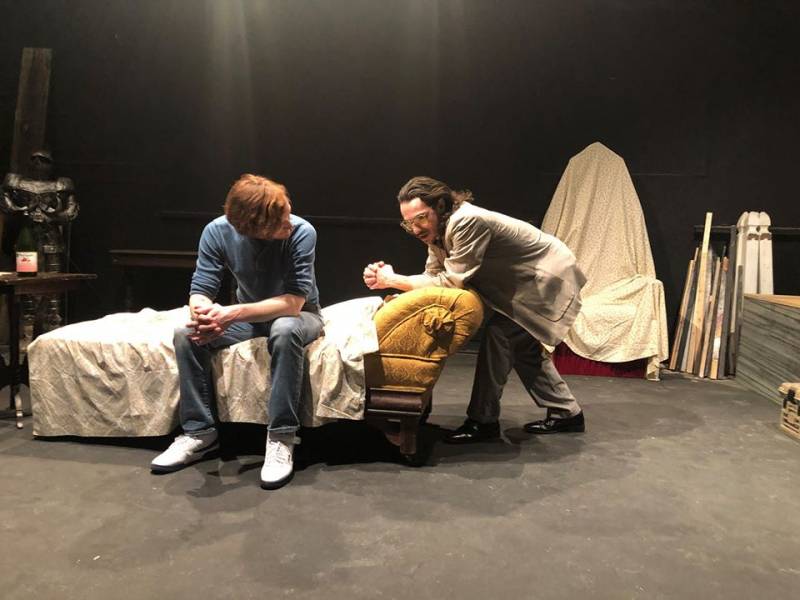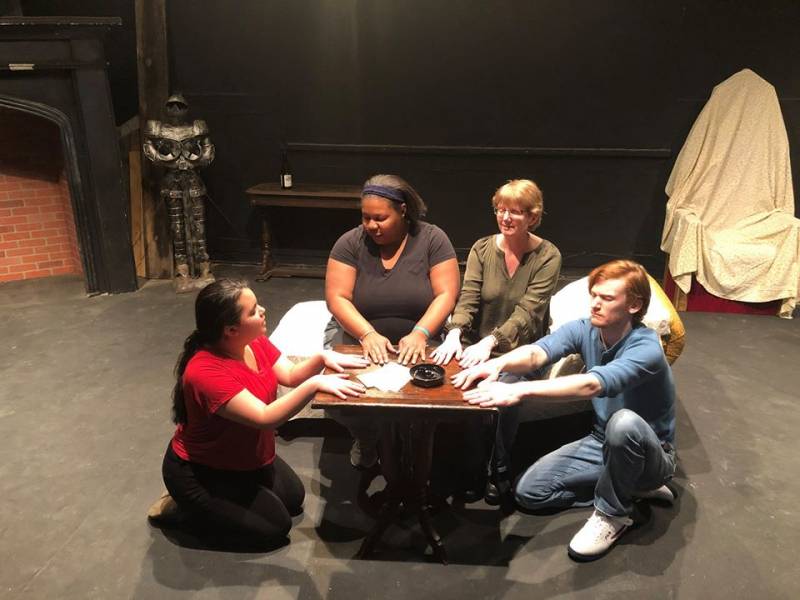The set-up for the Station Theatre’s upcoming comedy is undeniably fun: Andrew Rally is a successful TV actor who relocates to New York, where he rents a marvelous, gothic apartment and prepares for the potentially life-changing opportunity to play Hamlet for Shakespeare in the Park. There’s just one problem: He hates Hamlet. This dilemma is further complicated by the arrival of the ghost of famed Shakespearean actor John Barrymore, whose own performance as the Danish prince was legendary. The wildly different actors then clash over everything from art and success to women and even the apartment.
The play, which the New York Times called “unapologetically silly and at times hilarious,” opens this week under the direction of KT Burke. I chatted with Burke about the play, which is intentionally dripping in ‘90s nostalgia.
Smile Politely: So, when you first read this play, what appealed to you first/most?
KT Burke: The first thing that appealed to me was the title itself. I first encountered Hamlet during a difficult part of my life that hauntingly corresponded with some of the plot points of the script. While I typically loved reading plays aloud in English class, this particular play was too painful for me. I found myself truly resenting the text, and I can’t help but tie the work to the bitter memories I have from this time of my life.
That being said, directing this play is actually a bit cathartic for me. As I dove deeper into my theatre journey, I started studying Shakespeare/Hamlet from a theatre perspective (rather than a high school English class perspective). Through this and after some personal healing, I came to appreciate the story in its context; much like the lead character Andrew Rally (played by Andrew Simek).
Reading the script for the first time, I was really drawn to the arc of the story. It is a classic comedy with three parts to the story: six weeks before the show, the night of the show, and the morning after Andrew first performs as Hamlet. Additionally, I loved the historical elements of the show. It was a great deal of fun doing some research on John Barrymore (played by Kevin Wickart), the architecture of the Greenwich Village Apartment he used to live in, and all of the random references of the play. This version of the play was published in 1991 and is five years my senior, so I had to look into several of the references playwright Paul Rudnick makes.

Image: Photo from rehearsal featuring red-haired actor is seated on a chaise longue while a dark-haired actor stands to his left leaning over. Photo by Linda Evans.
SP: Did you immediately foresee any difficulties in bringing this to the stage? For instance, did the time period pose any challenges?
Burke: The time period did pose a bit of the challenge. Andrew and his L.A. director-producer-writer “friend” Gary (Jace Jamison) use cellphones, which were not widely common at the time. Jace is extremely gifted at finding authentic tech props, and secured a large, chunky antenna phone for us. Additionally, finding some of the costume pieces was tough. Currently ’90s fashion is in with Gen Z, so finding authentic light-wash jeans for Andrew was unfortunately out of the question. Costume designer Sheri Doyle does a great job at rooting the show in its time period with key costume items, such as Andrew’s loud athletic jacket.
The major difficulty I anticipated was the Errol Flynn-style fight that occurs at a dramatic point in the play. In this moment, the characters become frustrated with one another which results in violence. Sometimes directors have to admit to themselves that no, they are indeed not equipped to tackle all elements of their play. Luckily, I was able to call in fight director Danny Yoerges to choregraph this high-action sequence. Additionally, I brought in an intimacy director, Anastasia Kasimos, to guide the romantic elements. They were both a pleasure to work with!
SP: I know a director frequently begins with a particular vision of a play that can evolve during rehearsal. Did the rehearsal process bring about any evolutions of this sort?
Burke: I Hate Hamlet is a bit different than the shows I find myself gravitating towards. Typically, I find myself looking at high concept shows, such as my immersive Mamma Mia! or Silent Sky, which was in the “alley” with audience on two sides, actors in the middle. In the spirit of this, I prefer to direct shows in a non-traditional seating set up. My brain likes to play with shapes, specifically triangles, which makes working in the traditional Station proscenium set-up feel a little unnatural for me. (The proscenium set-up includes audience one side and the actors on the other, which is typically the theatre standard.)
We did not have a scenic designer until right before rehearsal started, which made it difficult for me to change the layout of the space. We had expected to DIY the set and re-purpose the items and seating arrangement from The Moors. I am so thankful that our scenic designer Graham Louthan was able to step in and create gorgeous work, but by that point I had already begun planning in proscenium style. In an alternate universe, this play would be presented in a “3/4 thrust,” or with audience members on three sides of the theatre.

Image: Photo of cast members rehearsing a seance, with hands spread on a wooden table. Photo by Linda Evans.
SP: Your previous directorial efforts at the Station seem pretty different at first glance. Silent Sky was a relatively new, small-cast drama about women in science, whereas Mamma Mia! is a jukebox musical with a huge cast. But, beneath the surface, they have the commonality of strong, independent women who band together and support each other. What are the women in I Hate Hamlet like? Would you say they also reflect this sensibility?
Burke: As a younger director, I am still working out what my style is. It’s been fun to play around with different genres and test the waters of my interest. And as a young woman director, I definitely gravitate towards female characters with agency, like astronomer Henrietta Leavitt in Silent Sky, or musician/entrepreneur Donna in Mamma Mia! I like to tell stories I can relate to, so stories from the feminine perspective are typically my cup of tea.
It is important to acknowledge that my last two shows at the Station were written by women; Lauren Gunderson and Catherine Johnson, respectively. I Hate Hamlet was a play written in the late 80s/early 90s by Paul Rudnick who is a man. It’s sad to say, but definitely not surprising, that this play horrendously fails the Bechdel Test. That being said, the wonderful actresses I worked with have brought agency and sensibility to their roles. These women team up in the beginning of the play to kick off the action, and they band together to surpass Andrew’s whiny rejection to a séance.
Madelyn Childress plays Deidre McDavey. Though she has childish tendencies, Deirdre stands her ground and takes full ownership of her body. She rejects her boyfriend Andrew’s physical advances, staying true to her personal virtues. Mary Rose Cottingham portrays Lillian Troy, a cut-throat and fashionable German woman who is a powerful casting agent in the film and theatrical fields. Misty Martin is realtor Felicia Dantine, who knows how to use her femininity and charm to advance her career aspirations in becoming a Beverly Hills real estate agent.
SP: In closing, and in case any potential audience members are wondering, how much do they need to know the play Hamlet in order to enjoy I Hate Hamlet?
Burke: You truly don’t need to know Hamlet at all to see this play. Elements and references are there, but nothing is too complex for unfamiliar ears to follow. However, the wonderful thing about Shakespearean tales is that their plot lines are oftentimes familiar to those who aren’t fans of the Bard. These same stories appear throughout our pop culture and media. If you’ve ever seen The Lion King, you’ve seen Hamlet!
I Hate Hamlet
The Celebration Company at the Station Theatre
223 N Broadway Ave
Urbana
February 13th through 29th
Get tickets here







